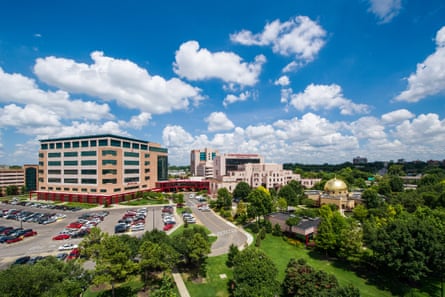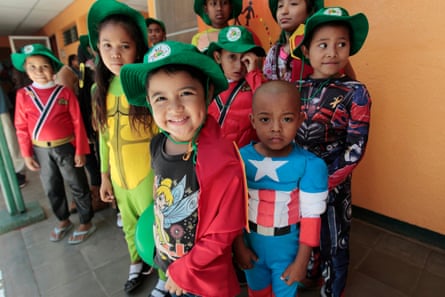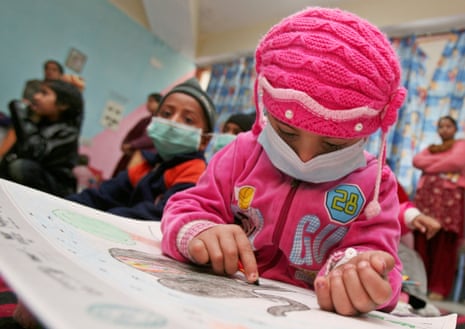The death of a child from cancer is a terrible but increasingly rare event in affluent nations – where mortality rates are at an all-time low with more than eight in 10 sufferers now surviving childhood cancer. In contrast, in low-income countries, children routinely die of diseases that can be cured: only three out of 10 who get cancer will survive.
The odds are likely to be worse, because an estimated 50% of all children with cancer never get a diagnosis.
The west has invested huge resources into fighting infectious diseases in poor countries, reducing the death toll from Aids, malaria and TB. But cancer has been seen as being on the “too-difficult” pile. The obstacles were huge: too few specialist doctors and nurses, hospitals that don’t have X-ray machines let alone MRI scanners or radiology equipment. And the high cost of chemotherapy drugs.
Quick GuideA common condition
Show
The human toll of non-communicable diseases (NCDs) is huge and rising. These illnesses end the lives of approximately 41 million of the 56 million people who die every year – and three quarters of them are in the developing world.
NCDs are simply that; unlike, say, a virus, you can’t catch them. Instead, they are caused by a combination of genetic, physiological, environmental and behavioural factors. The main types are cancers, chronic respiratory illnesses, diabetes and cardiovascular disease – heart attacks and stroke. Approximately 80% are preventable, and all are on the rise, spreading inexorably around the world as ageing populations and lifestyles pushed by economic growth and urbanisation make being unhealthy a global phenomenon.
NCDs, once seen as illnesses of the wealthy, now have a grip on the poor. Disease, disability and death are perfectly designed to create and widen inequality – and being poor makes it less likely you will be diagnosed accurately or treated.
Investment in tackling these common and chronic conditions that kill 71% of us is incredibly low, while the cost to families, economies and communities is staggeringly high.
In low-income countries NCDs – typically slow and debilitating illnesses – are seeing a fraction of the money needed being invested or donated. Attention remains focused on the threats from communicable diseases, yet cancer death rates have long sped past the death toll from malaria, TB and HIV/Aids combined.
'A common condition' is a Guardian series reporting on NCDs in the developing world: their prevalence, the solutions, the causes and consequences, telling the stories of people living with these illnesses.
Tracy McVeigh, editor
In Memphis, Tennessee, a hospital is leading the world’s renewed fight against childhood cancer thanks to its own resources, its celebrity backers and a motto that “no child should die in the dawn of life” – not just no American child.
St Jude children’s research hospital owes its existence to a 1950s American entertainer who began life as Amos Muzyad Yaqoob Kairouz, the son of Maronite Catholics who came to the US from Lebanon looking for a better life. A devotee of St Jude Thaddeus, the patron saint of hopeless causes, the entertainer made a promise to a statue of the saint that he’d repay any success that came his way. After changing his name to Danny Thomas and becoming a household name on US television, he raised the money to build St Jude hospital, dedicated to treating children with cancer and other catastrophic diseases. It opened in 1962.
Dr James Downing, the hospital’s CEO, says the mission was ambitious from the start, “to advance cures and means of prevention against paediatric catastrophic diseases through research and treatment … It has always thought of itself as unique in the broad ecosystem of healthcare for paediatric patients. And so it is always asked, you know, if not St Jude, who? And so, what does the world need? What are the problems that exist? Do we have the expertise to tackle those problems? Is it on mission for us? And can we raise the money to actually be able to tackle those problems?”
In partnership with the World Health Organization, St Jude is at the forefront of work to transform treatment for children in low- and middle-income countries. St Jude is training doctors, supporting hospitals and now investing $200m (£163m) to get cancer medicines to 120,000 children by 2027. Deliveries to the first six countries should begin in the autumn or early 2024.
It’s a big challenge. Many countries in Africa and Asia are short of even the most basic medicines. Drug supply chains are ponderous and fragmented. Medicines get diverted and sold on the hidden market. Some are substandard or counterfeit and will do more harm than good. In January, the Bureau of Investigative Journalism revealed that at least a dozen brands of the children’s cancer drug asparaginase were below standard, containing too little of the active ingredient and sometimes dangerous contaminants. For the past five years supplies of these drugs have been shipped to nearly 100 countries around the world.

Downing recognises the pitfalls but remains optimistic. Indeed, money appears not to be an issue. In 2021, St Jude raised $2bn in donations. Celebrities including Jennifer Aniston, Jim Carrey, Sharon Stone and John Travolta have given or raised money. Domino’s Pizza has pledged $100m. The biggest source of funds is a direct mail pledge programme called Partners in Hope, which brings in money from families and individuals across the US.
In the 1960s, St Jude’s first focus was on acute lymphoblastic leukaemia. St Jude research teams helped push the cure rate up from 50% to above 90%. They then began to explore international links, twinning with a hospital in El Salvador.
“We taught the doctors and the administrators and the nurses what it takes to treat a child with cancer,” says Downing. “We focused on acute lymphoblastic leukaemia in that single hospital and we were able to raise the cure rates from 20% to 60% for less than a million dollars over several years.” The St Jude initiative expanded over more than 20 years to 24 programmes in 17 countries, mainly in Central and South America.
When Downing became scientific director, before he took over as CEO, he asked Tachi Yamada, who had been head of the Gates global health programme, to review the work. Yamada said two things that stuck: the programme wasn’t scalable – and drugs would be a problem.
To scale it, he and his colleagues built a global programme based on learning. They set up a St Jude global academy to train people to educate doctors and other hospital staff. They partnered with the WHO to help governments understand their capacity for childhood cancer care and how to improve it. The St Jude Global Alliance, comprising 200 institutions in 80 countries, was established. St Jude teaches them how to do clinical research, a vital part of cancer care.
Three years ago, Downing returned to Yamada’s point: what are we going to do about drugs? “We know there are shortages, we know patients are getting bad drugs and we know that even of those that have access to drugs, more than half have disruption in their therapy because of inconsistent access. We know it’s a financial burden. So what are we going to do and let’s just take a clean sheet of paper and think globally.”
after newsletter promotion
Six countries will soon test out the solutions St Jude, WHO and Unicef have come up with. They are looking at blockchain technology to track supplies to the patients. It would be naive to think diversion wouldn’t be an issue, says Downing. They are working with governments, not shipping drugs themselves to clinics, as happened with HIV. It opens the possibility of real reform of drug supply.
Unicef has long experience of sourcing and supplying medicines for low-income countries. Dorcas Noertoft, chief of procurement services, is enthusiastic about the programme. “I particularly like the way that it’s being done, working with the government, making sure that they are with you the whole way,” she says. With the expertise of WHO, Unicef and St Jude, there will be a lot of learning over the years to come. “Things will change,” she says.

André Ilbawi, technical lead for WHO’s cancer control programme, is enthusiastic. “This is for us a generational opportunity,” he says, to tackle the “persistent challenge” of access to care and medicines not only in childhood cancer but, in the future, adult cancer and other non-communicable diseases.
The programme offers “end-to-end support”, he says. It’s not just about delivering the medicines, but about the safe handling and storing of chemotherapy drugs. Other work “will look at the context by which these medicines are developed, purchased, quantified, delivered, handled, prescribed, dispensed and also discarded because there are situations where chemotherapy drugs can be left on wards or dumped in pits by hospitals, which also have concerns or threats to the community,” he says.
But drug supply is just one problem. Half the children with cancer in the world never get a diagnosis. Now the experts are working on how to make it easier for healthcare professionals to identify the disease.
“I truly believe that we will learn more by partnering with low- and middle-income countries than they will learn from us,” says Downing. “We will learn about experiments of nature [unexpected events that naturally occur]. Maybe we’re overtreating some children. We will learn a tremendous amount about the delivery of care.”
Downing has done a lot of impressive things in his life; leading the children’s cancer genome project was one of them. But, he says: “This may be the most important thing I ever do. It has the potential to impact kids everywhere and save millions of lives and wash back on the developed world.”
